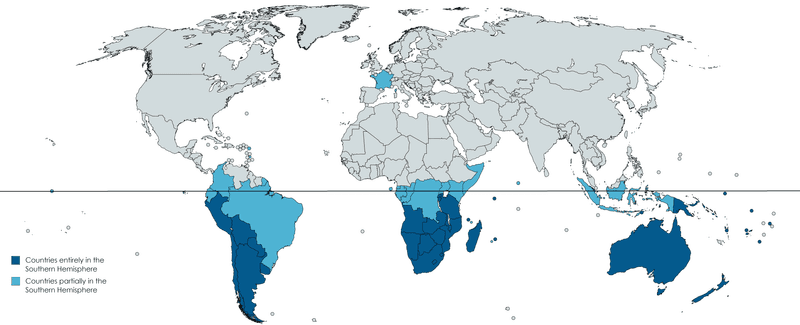
Understanding the geographical distribution of continents is vital to comprehending the world’s ecological and cultural diversity. Various delineations of global territories reveal an intriguing aspect of the Earth’s geographical makeup—specifically, the continents that lie entirely within the confines of the Southern Hemisphere. This exploration serves not only as an educational endeavor but also as an invitation to expand your awareness of global geography.
To elucidate which continents reside wholly within the Southern Hemisphere, we must first position ourselves within the context of the globe. The Southern Hemisphere is delineated by the equator, the imaginary line that projects the Earth’s surface into two hemispheres—the northern and southern halves. With this foundational understanding, we are poised to dive into the examination of noteworthy continents.
There are two continents that lie entirely within the Southern Hemisphere: Australia and Antarctica. Each of these landmasses offers a distinct ecological and cultural experience, characterized by unique biodiversity and geographical features.
Australia: A Land of Contrasts
Australia, often referred to as “the Land Down Under,” is the sixth-largest country in the world by total area and is the only continent that is both a country and an island. Encompassing vast deserts, lush rainforests, and spectacular coastlines, Australia presents a microcosm of biodiversity. It is well known for its endemic species, a result of its long geographic isolation. From the iconic kangaroo to the spine-tingling call of the lyrebird, Australia’s wildlife captivates and enchants.
Furthermore, Australia’s topography varies significantly from one region to another. The Outback, characterized by arid landscapes, contrasts starkly with the temperate regions along the eastern coastline, where cities like Sydney and Melbourne thrive. The Great Barrier Reef, a UNESCO World Heritage site, is a prime example of Australia’s rich marine environments, fostering an array of marine life that attracts divers and researchers from around the globe.
Besides its natural wonders, Australia is also a melting pot of cultures, influenced by its Indigenous Peoples and subsequent waves of immigration. The vibrant cities are hubs of multiculturalism, boasting festivals, art, and culinary experiences that reflect the diverse tapestry of society.
Antarctica: The Frozen Frontier
In stark contrast to Australia, Antarctica embodies extreme conditions. As the southernmost continent, it is predominantly covered by ice, presenting a formidable environment that is inhospitable to human life in the traditional sense. Despite this, Antarctica is paramount in discussions about climate change, global weather patterns, and scientific research. Its ice sheets hold about 60% of the world’s fresh water and provide critical data regarding historical climate conditions.
Furthermore, Antarctica plays a vital role in supporting a unique ecosystem, albeit limited. Species such as penguins, seals, and various seabirds have adapted to the frigid temperatures, creating a precarious yet captivating cycle of life. The continent operates under the Antarctic Treaty System, a remarkable example of international cooperation, aimed at preserving the fragile environment while allowing for scientific exploration.
Geopolitical Implications
The existence of these two wholly Southern Hemisphere continents carries significant geopolitical implications. Australia, as a developed nation, plays an influential role in regional and global politics, engaging in various international affairs. Its geographic position also renders it a critical point in addressing issues such as climate change, trade relations, and environmental conservation.
Conversely, Antarctica raises complex geopolitical queries. While it has no sovereign nations, multiple countries possess territorial claims. The potential for resource extraction, exacerbated by melting ice due to climate change, poses ethical dilemmas and challenges to international governance. Understanding the implications of these territories is crucial, particularly as global attention turns to environmental preservation and sustainable practices.
Conclusion: A Global Perspective
The continents entirely located in the Southern Hemisphere, Australia and Antarctica, represent not only unique geographical entities but also encapsulate broader narratives about environmental stewardship, cultural diversity, and international relations. As the world faces unprecedented challenges relating to climate change and globalization, the importance of understanding the distinct characteristics and conditions of these continents becomes ever more evident.
By engaging with these geographical realities, we are not merely observing the world; we are compelled to participate in an ongoing dialogue about our planet’s future. The more we comprehend the intricate fabric of global geography—including those continents that reside within the Southern Hemisphere—the more equipped we become to advocate for thoughtful action and conscientious stewardship of our shared home.
In summation, Australia and Antarctica serve as more than mere geographical markers. They are vivid reminders of the incredible diversity our world possesses, broadening our perspectives and spurring our curiosity towards the mysteries that lie beyond familiar horizons.
